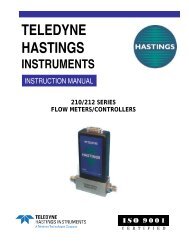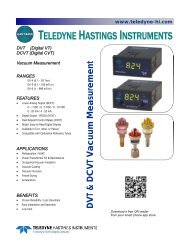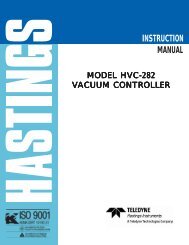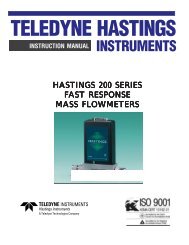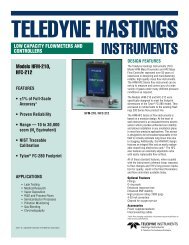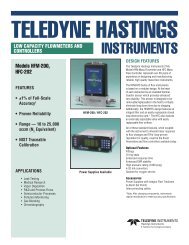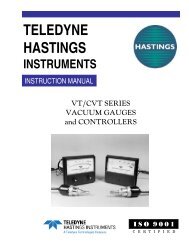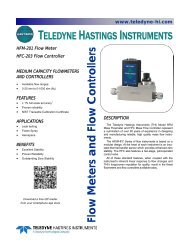HFM-301/305 HFC-303/307 - Teledyne Hastings Instruments
HFM-301/305 HFC-303/307 - Teledyne Hastings Instruments
HFM-301/305 HFC-303/307 - Teledyne Hastings Instruments
- No tags were found...
You also want an ePaper? Increase the reach of your titles
YUMPU automatically turns print PDFs into web optimized ePapers that Google loves.
2<br />
128μLQ<br />
8ρQ<br />
ΔP = +<br />
D D K K<br />
4 2 4 c<br />
+<br />
π π<br />
( )<br />
e<br />
The end effects for a typical laminar flow element in air account for approximately 4% of the total<br />
pressure drop. For hydrogen, however, which has a density that is about 14 times less than air and has a<br />
viscosity that is much greater than air, the second term is completely negligible. For the heavier gasses<br />
such as sulfur hexafluoride which has a density 5 times that of air the end effects will become 10% of the<br />
total. These changes make it impossible to accurately calibrate an instrument on one gas and use it for<br />
another gas.<br />
The pressure drop is linear with respect to the volumetric flow rate between a point that is downstream<br />
of the entrance area and another point further downstream but upstream of the exit region. For a<br />
typical flow divider tube the entry length is approximately 0.16 cm. From this it can be seen that if the<br />
sensor inlet pickup point is inside of the flow divider tube but downstream of the entrance length and if<br />
the sensor outlet point is inside the flow divider tube but upstream of the exit point then the pressure<br />
drop that drives the flow through the sensor would be linear with respect to volumetric flow rate. Since<br />
the pressure drop across the sensor now increases linearly with the main flow rate and the sensor has a<br />
linearly increasing flow with respect to pressure drop, there is now a flow through the sensor which is<br />
directly proportional to the main flow through the flow divider, without the flow division errors that are<br />
present when the sensor samples the flow completely upstream and downstream of the flow divider.<br />
Unfortunately, a typical shunt has an internal diameter on the order of 0.3 mm. This is too small to<br />
insert tap points into the tube. Also, the sample flow through the sensor is approximately 10 sccm while<br />
the flow through a shunt is approximately 25 sccm. This means the sample flow would be affecting the<br />
flow it was trying to measure. If the sensor tube is made large enough, and with enough flow through it<br />
to insert the sensor taps at these positions, then the pressure drop would be too small to push the<br />
necessary flow through the sensor tube.<br />
The solution is to use a different geometry for the flow tube. It must be large enough to allow the<br />
sample points in the middle yet with passages thin enough to create the differential pressures required<br />
for the sensor. An annular passage meets these requirements. All of the 400 I series shunts have an<br />
annular passageway that passes between the outside of the main shunt body and the inside edge of the<br />
base where the sensor taps are located.<br />
Figure 3-2<br />
The shunt must generate a pressure drop at the desired full scale flow which drives the proper flow<br />
through the sensor tube to generate a full scale output from the sensor. Since the full scale flow of the<br />
sensor is the same for all of the different full scale flows that may pass through the shunt, the geometry<br />
must vary for the different full scale flows in order to generate the same pressured drop for all of them.<br />
This is accomplished by adding more channels to main shunt body. As the full scale flow rate increases<br />
the flow meter body must get larger to allow room for the increased number of bypass passageways that<br />
are required.<br />
Manual: 152-082010 <strong>301</strong>-<strong>305</strong>-306_<strong>303</strong>-<strong>307</strong> Series Page 22 of 35



